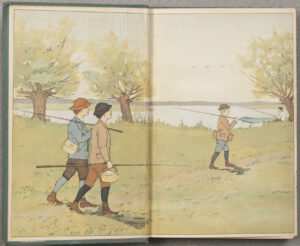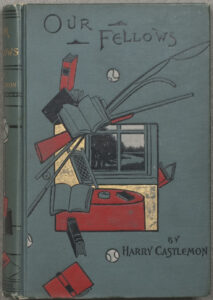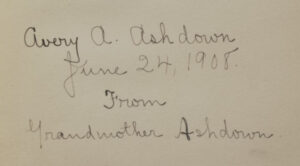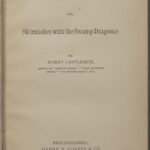 Published: Philadelphia, ca. 1908
Published: Philadelphia, ca. 1908
The MIT Libraries own just a small number of titles aimed specifically at juvenile readers, and those few have generally made it into the collection by virtue of their provenance. A case in point: Harry Castlemon’s Our Fellows, or, Skirmishes with the Swamp Dragoons.
Castlemon (real name: Charles Austin Fosdick) was born in New York State in 1842. He was a driving force behind the creation of “series books” for youngsters – a publishing phenomenon that would continue into the present with no end in sight, and come to include such moneymakers as Nancy Drew, The Hardy Boys, Baby-sitters’ Club, and Diary of a Wimpy Kid.
Castlemon wrote books by the dozen in the late 19th century and got rich doing it. Directed at an audience of young boys, his books featured adventure, good clean fun, and moral uplift.
They also featured a casual racism that appalls us in the 21st century but was pervasive in 1887, when this title was first published. A mere five sentences into Our Fellows, the heroes – twin boys – have already had trouble with a “half-breed,” and the trouble won’t stop there. Just a few pages later we learn that the local Choctaws are “lazy dogs.” Even by the standards associated with the literature of “cowboys and Indians,” Castlemon’s work is notable for its vicious portrayal of Native Americans. Still, there’s nothing truly extraordinary about the book’s general tone, which was within the mainstream when it came to adventure stories for boys in the late 19th century.
 As an object, the volume itself is nice looking, with a handsome cover and colorful endpapers. MIT owns this reprint edition because it was a gift from “Grandmother Ashdown,” in 1908, to Avery Ashdown, then a young teen. Ashdown (MIT Ph.D., 1924) taught chemistry at the Institute for decades, and served for many years as the beloved housemaster of the first building on campus to house graduate students. The facility would eventually come to be named for Ashdown, whose ashes, at his own request, were buried in its courtyard.
As an object, the volume itself is nice looking, with a handsome cover and colorful endpapers. MIT owns this reprint edition because it was a gift from “Grandmother Ashdown,” in 1908, to Avery Ashdown, then a young teen. Ashdown (MIT Ph.D., 1924) taught chemistry at the Institute for decades, and served for many years as the beloved housemaster of the first building on campus to house graduate students. The facility would eventually come to be named for Ashdown, whose ashes, at his own request, were buried in its courtyard.


